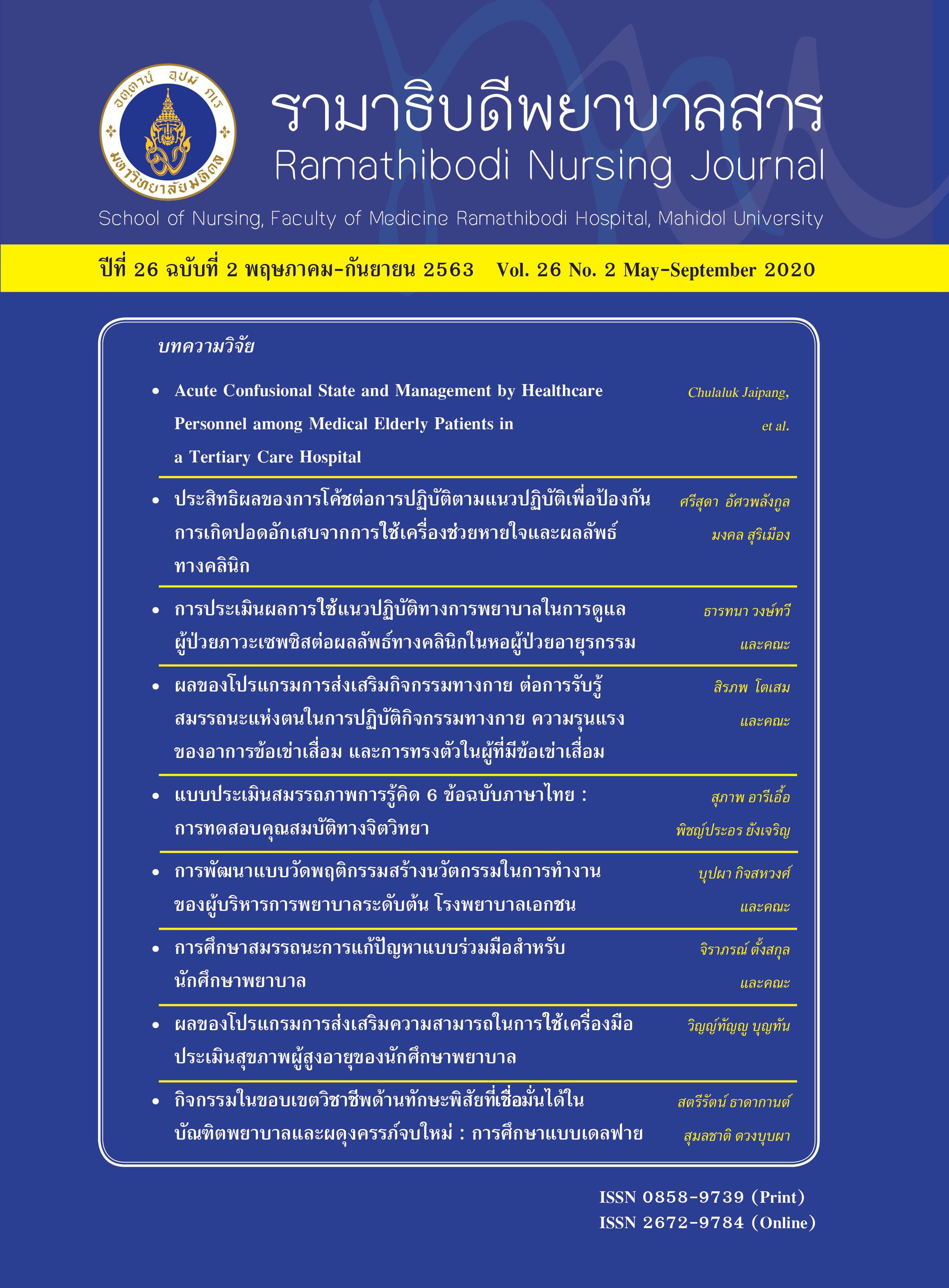A Study of Collaborative Problem-Solving Competency for Nursing Students
Main Article Content
Abstract
This qualitative descriptive research aimed to examine collaborative problemsolving competency in nursing students. In-depth interviews were used for data collection with eight participants who were nurse instructors and nurses who had received the Nursing Practice Excellence Awards from their hospitals or nursing organizations. The result of the study illustrated that the meaning of collaborative problem solving
competency for nursing students was the student’s behaviors to motivate others to engage in team-based problem solving, to think about all possible solutions to solve a problem,and reach the ultimate goal and everybody’s satisfaction by taking the benefit of the group into account. The collaborative problem-solving competency comprised three different competencies with eight total components: 1) the competency of establishing and maintaining their understanding of each other, consisting of three components
(Collecting/Researching Data, Sharing Data, and Confirming Data); 2) the competency of selecting a proper solution in solving problems, consisting of two components (Connecting Data, Making Decisions); 3) the competency of establishing and maintaining an organizational team, consisting of three components (Teamwork, Support Groups, and Evaluation and Improvement). Therefore, this collaborative problemsolving
capability in nursing students can be used to determine expected learning outcomes and to design learning management that empowers nursing students with collaborative problem-solving abilities to work effectively with health teams.
Article Details
บทความ ข้อมูล เนื้อหา รูปภาพ ฯลฯ ที่ได้รับการตีพิมพ์ในรามาธิบดีพยาบาลสาร ถือเป็นลิขสิทธิ์ของวารสาร หากบุคคลหรือหน่วยงานใดต้องการนำทั้งหมดหรือส่วนหนึ่งส่วนใดไปเผยแพร่หรือเพื่อกระทำการใด ใด จะต้องได้รับอนุญาตเป็นลายลักษณ์อักษรจากรามาธิบดีพยาบาลสารก่อนเท่านั้น
References
Panich V. Method for building the learning of students in 21st century. Bangkok: Saritwong Foundation; 2013. (inThai)
Neadratsamee C. An action research on development of stem education based on engineering design process for promoting collaborative problem solving competencies on environmental chemistry of 10th grade student. Journal of Rangsit University: Teaching & Learning.2019;13(1):29-35. (in Thai)
Organisation for Economic Co-operation and Development (OECD). PISA 2015 assessment and analytical
framework: science, reading, mathematic, financial literacy and collaborative problem solving (revised ed.). Paris:
OECD Publishing; 2017. p.134-35.
Rosen Y, Foltz PW. Assessing collaborative problem s o l v i n g t h r o u g h a u t o m a t e d t e c h n o l o g i e s .RPTEL.2014;9(3):389-410.
Office of the Education Council. Educational reform in Thailand: The second decade. Bangkok: Ministry of
Education; 2009.p.12-6. (in Thai)
Meaning of National Economic and Social Development.Twelfth National Economic and Social Development Plan (2017-2021) Bangkok: Office of the National Economic and Social Development; 2012. (in Thai)
Kunaviktikul W. Teaching and learning in the discipline of nursing in the 21st century. Nursing Journal.
;42(2):152-6. (in Thai)
Turner K. Twenty first century skills of nursing students of Boromarajonani College of Nursing, Chonburi. Nursing Journal of the Ministry of Public Health. 2015;25(2):178-93. (in Thai)
Pantaewan P. Development of students in the 21st century with active learning in nursing profession. Journal of The Royal Thai Army Nurses. 2016;17(3):17-24. (in Thai)
Chantra R. Learning skills in 21st century of nursing students at Boromarajonani College of Nursing, Suratthani.The Southern College Network Journal of Nursing and Public Health. 2017;4(1):180-90. (in Thai)
Naboonmee P. Problem-based learning for developing collaborative problem solving competency in rotational motion topic for grade 10th students. JOE, MSU.2019;113(2):194-205. (in Thai)
Chaidech T. Development of collaborative problem solving competency using research-based learning according to STEM education in fossil fuels and products. JSTEL.2017;8(1):51-66. (in Thai)
Kraichan S. The Leadership and teamwork as perceived by nursing student of nurse preceptor of nursing
administration practicum. Srimahasarakham College of Nursing. 2013;8(1):169-75. (in Thai)
Graesser A, Kuo B-C, Liao C-H. Complex problem solving in assessments of collaborative problem solving.
Journal of intelligence. 2017;5(2):1-14.
Polyak ST, von Davier AA, Peterschmidt K. Analyzing game-based collaborative problem solving with
computational psychometrics; 2017 [cited 2019 November 28]. Available from: https://actnext.org/wp-content/uploads/KDD_Polyak_et_al.pdf.
Pöysä-Tarhonen J, Care E, Awwal N, Häkkinen P. Pair interactions in online assessments of collaborative problem solving: case-based portraits. Research and Practice in Technology Enhanced Learning. 2018;13(12):1-29.
Vu Phuong L, Tran Thi VT, Tran Trung N. Evaluate students’ collaborative problem-solving skills through an
experiential approach to teach non-metals (A case study in high school of education sciences and Viet Duc High
School in Hanoi, Vietnam). World J. Chem. Educ.2018;6(4):190-99.
Cai H, Lin L, Gu X. Using a semantic diagram to structure a collaborative problem solving process in the Classroom;2016 [cited 2019 November 28]. Available from:https://www.researchgate.net/ publication/301828737
Scoular C, Care E. Monitoring patterns of social and cognitive student behaviors in online collaborative problem solving assessments; 2019 [cited 2019 November 28].Available from: https://www. sciencedirect.com/
science/article/pii/S0747563219300172?via%3Dihub
Bureau of Academic Affairs and Educational Standards Office of the Basic Education Commission. Collaborative problem solving. Bangkok: Ministry of Education; 2015.(in Thai)
Miles MB, Huberman AM. Qualitative Data Analysis: An Expanded Sourcebook. Thousand Oaks, CA: Sage
Publications; 1994.
Guba EG, Lincon Y. Fourth generation evaluation.Newbury Park, CA: Sage; 1989.
Hemaprasit S, Sukwan O. The enhancement of learning management quality under Thai qualifications framework for higher education (TQF: HEd) for per service teachers through constructivism. Srinakharinwirot Research and Development (Journal of Humanities and Social Sciences).2015;7(13):165-86. (in Thai)
Covey SR. The 7 habits of highly effective people:powerful lessons in personal change. 25th anniversary
edition. New York: Simon & Schuste; 2013.
Thai Qualifications Framework for Higher Education. The qualification standard for a bachelor’s degree in nursing;2017 [cited 2020 April 20]. Available from: http://www.mua.go.th /users/tqf-hed/news/news6.php
Weber EP, Lovrich NP, Gaffney M. Collaboration,enforcement, and endangered species: a framework
for assessing collaborative problem-solving capacity. Soc.Nat. Resour. 2005;18(8) :677-98.
Kunaviktikul W. Teaching and learning in the discipline of nursing in the 21st century. Nursing Journal.
;42(2):152-6. (in Thai)
Lencoioni P. The five dysfunctions of a team. San Francisco: Jossey-Bass Publishers; 2002.
Jeffreys MR. Nursing student retention understanding the process and making a difference, 2nd ed. New York:Springer Publishing Company; 2012, p.110-12.


